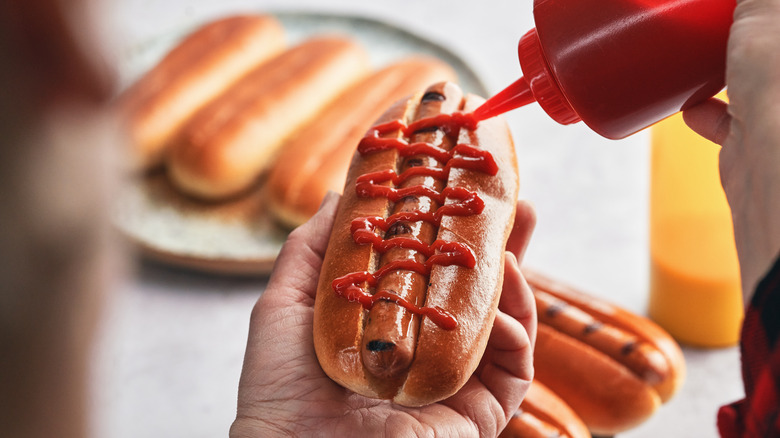The Unhealthiest Toppings You Can Put On A Hot Dog
Right there next to burgers, hot dogs are a quintessentially American food. Popular at backyard get-togethers and barbecues, hot dogs are also a staple at baseball games, movie theaters, fairs, and random street corners in many major cities across the U.S. Like with any widely popular food, everyone has their own way of enjoying them. For some people, it's all about the meat 一 whether it's all-beef, a blend of beef and pork, turkey, or even tofu, there's something for everyone. For others, it's the quality of the bread holding everything together. However, for many, what really matters are the toppings.
Realistically, you can put almost anything on a hot dog. You can opt for the classics or flex your creative muscles, trying out new flavor combinations. Some toppings, however, are generally considered healthier than others. To help you narrow down your choices, we put together a list of popular toppings that are high in sugar, sodium, and fat and also often contain unwanted additives and preservatives. For more on our selection process, see the methodology section at the end of the article. Remember, we all have unique dietary needs and can make our own choices regarding food. Most people typically use only small amounts of these toppings. Plus, it's worth noting that many of them can be enjoyed in moderation.
Ketchup
Available on restaurant tables everywhere, ketchup is one of the most popular condiments in the U.S. The tangy tomato-based sauce perfectly complements a variety of foods, including french fries, burgers, and, of course, hot dogs. But it may come as no surprise that ketchup is no health food. The condiment typically contains significant amounts of sugar and sodium, and some brands use high fructose corn syrup and other unsavory ingredients.
To take the ubiquitous brand Heinz as an example, a one tablespoon serving of its Tomato Ketchup has 4 grams of added sugar. While it's a small amount, it can add up 一 Americans on average eat too much added sugar. The American Heart Association advises limiting added sugar intake each day to no more than 36 grams for men and 25 grams for women. What's more, Heinz Tomato Ketchup is sweetened with high fructose corn syrup, which, if consumed in large amounts, can increase your chances of developing diabetes, obesity, and high blood pressure, according to the Cleveland Clinic. Heinz, like many ketchups, is also high in sodium (180 milligrams per tablespoon), so consider sticking to the recommended serving size.
Cheese
Whether sprinkled on top or melted, cheese is a delicious addition to just about anything, hot dogs included. While fine in moderation, cheese can be unhealthy when consumed in excess. That's because a lot of varieties contain saturated fat, which can increase the amount of bad cholesterol in your blood. The U.S. Department of Agriculture's Dietary Guidelines for Americans advise that saturated fat should make up no more than 10% of your daily calories.
Additionally, cheese can be high in sodium. An ounce of cheddar cheese, for example, has about 190 milligrams of sodium. But if you choose a more processed cheese product, like Velveeta, an ounce packs 390 milligrams of sodium 一 17% of the value that the U.S. Food and Drug Administration (FDA) recommends people consume in a day. Add in the sodium from the hot dog itself (which can be substantial) and any other toppings, and it's easy to see how anyone can overindulge on sodium in a single day. Excessive sodium intake can increase blood pressure, especially in those who are sensitive to the nutrient. Keep in mind that the FDA recommends we eat less than 2,300 milligrams of sodium per day. When choosing a cheese to top your hot dog, look for minimally processed options. Some packaged cheeses and cheese sauces are also made with artificial additives and preservatives.
Sour cream
Sour cream has many uses in cooking, but it's perhaps best known as a condiment, topping the likes of baked potatoes, tacos, and chili. Add hot dogs to that list, and the result is a deliciously tangy and creamy combination of flavors. But as you may suspect, sour cream typically runs high in fat and calories. It's worth noting that everyone's dietary needs and priorities are different. If the nutritional values for sour cream are something you're concerned about, you may want to limit your intake or choose reduced-fat varieties.
To show you what we mean, take a look at the popular brand Daisy. A serving (2 tablespoons) of Daisy Sour Cream contains 3.5 grams of saturated fat. While this doesn't seem like very much, it's actually 18% of the recommended daily value for saturated fat. By comparison, the brand's light sour cream has only 1.5 grams of saturated fat. On the plus side, Daisy's only ingredient is cultured cream (the light variety includes skim milk). Other brands may add preservatives and filler ingredients, so make sure to always read the nutrition label. Even then, with most sour creams, it's completely fine to enjoy them as an occasional garnish or topping.
Chili
Chili dogs look different from state to state, but at the end of the day they combine two of America's favorite foods: hot dogs and hearty, meaty chili. Unlike the chili you may enjoy in a bowl, hot dog chili doesn't typically contain beans. Instead, it's more like a thick meat sauce, often flavored with spices and vegetables. If the piling of meat upon more meat is any indicator, the chili dog has its drawbacks, at least health-wise.
If you go the canned chili route, sodium and saturated fat are the biggest concerns. One popular canned offering, Hormel No Beans Chili, contains 990 milligrams of sodium per 1-cup serving. That's 41% of the recommended daily value for sodium. To put things into perspective, the FDA considers any food with over 20% of the daily value to be high in sodium. Forget the hot dog 一 you can come close to reaching about half your daily allotment for sodium just with the chili.
A serving of Hormel chili also packs 5 grams of saturated fat, which is also high, according to the FDA's standards. Plus, the presence of fillers such as oatmeal and soy suggest the chili isn't made with the highest quality ingredients. If you're set on making chili dogs, make sure to always read the label on the back of the can. Another option is to make your chili from scratch so you can control the ingredients and sodium level.
Mayo or aioli
Delicious as is or mixed with sriracha or another hot sauce, mayo makes for a rich and creamy hot dog topping. While the condiment typically runs high in fat and sodium, sticking to the recommended serving size (1 tablespoon for most mayo brands) can help moderate your intake. If you decide to pick up a low-fat or light mayo instead, take a look at the ingredient list first. Some brands replace the fat with a variety of additives, including high fructose corn syrup and food starch. Mayo-like alternatives such as Miracle Whip are no different. Many mayo and mayo-like products are also made with soybean oil, a common ingredient in many processed foods. Soybean oil is highly popular in the U.S., but the regular consumption of the oil can lead to the development of diabetes, obesity, ulcerative colitis, and other health conditions. It's best to monitor and limit your intake of soybean oil.
Aioli is similar in nutritional content. Some variations are made with mayo, while others use olive oil, but all aioli relies on garlic as the central source of flavor. If buying a premade aioli, be aware that some bottled versions are soybean oil-based and contain additives. Of course, any aioli, like mayo, can be enjoyed occasionally. However, if you have the time and ability, it can be worthwhile to make your own batch of aioli.
Hot sauce
There's nothing that doesn't pair well with hot sauce, and hot dogs are no exception. Popular across many cuisines, hot sauces come in varying flavors, colors, and levels of spiciness. However, other than the sensitivity that some might have to the spice, hot sauces can have a lot of sodium, sugar, and additives in their make-up.
For example, Frank's Redhot Hot Honey Sauce has 480 milligrams of sodium and 6 grams of added sugar per serving. Luckily, a serving is 1 tablespoon, and most people likely won't use more than that anyway. Even so, the sauce's sodium levels are high, according to the FDA's guidelines. Another popular option, Louisiana Hot Sauce, packs a lot of sodium into an even smaller serving size: 1 teaspoon has 200 milligrams of sodium. A tablespoon is equal to three teaspoons, so if you were to eat a tablespoon's worth of Louisiana Hot Sauce, you'd consume roughly 600 milligrams of sodium. This highlights the importance of reading the label not only for the ingredients and nutrient content but also for the serving size.
Relish
Relish is one of the most common hot dog toppings you'll find, next to ketchup and mustard. This condiment is made of chopped-up veggies (usually cucumbers) pickled with vinegar, herbs, spices, and sometimes sugar. While tasty, many relishes available at stores are full of high fructose corn syrup, preservatives, and other additives.
For instance, Vlasic Sweet Relish contains all of the above. The preservative in question here is sodium benzoate, which may contribute to the development of several health issues. The biggest concern with sodium benzoate is its potential to turn into benzene, a toxic compound linked to some cancers. You'll also find Yellow 5, an artificial color additive that may harm the body if consumed regularly over a long period of time. If you have your heart set on sweet relish, look for options that limit these potentially unhealthy additives. One viable alternative is Whole Foods 365 brand Organic Sweet Relish, which contains no harmful preservatives or color additives. Plus, instead of high fructose corn syrup, it's made with real cane sugar. Of course, if you're monitoring your sugar intake, a sugar-free relish may be better suited to your needs.
Pickles
A few pickles can go a long way on a hot dog, bringing tang, saltiness, and a much-needed crunch. Pickles can easily be part of a healthy diet, and you may even have heard that they carry some health benefits. For example, fermented pickles (think sauerkraut) contain probiotics, which are good for a healthy gut. One thing that's indisputable, however, is that pickles tend to be very salty. All this salt is delicious, sure, but excessive sodium intake has its drawbacks.
In addition to high blood pressure, consuming too much sodium can lead to kidney disease, stroke, stomach cancer, and other health issues. According to the American Heart Association, 9 out of 10 Americans exceed the daily recommended sodium intake. To avoid going over this value (the group recommends limiting your intake to 1,500 milligrams per day), try to be mindful of the serving size that's listed on a product's nutrition label. For example, one serving of Claussen Kosher Dill Pickle Slices is equal to one and a half slices. Sticking to this serving size, you'll consume 380 milligrams of sodium, which is still a significant amount.
Another thing to consider with any store-bought pickles is the ingredient list. Some pickles contain high fructose corn syrup or sugar, while others have preservatives and artificial colors and flavors. The Claussen pickles, for instance, are made with sodium benzoate and high fructose corn syrup, despite not being labeled as sweet pickles.
Bacon
Bacon dogs are a crowd pleaser because sometimes a hot dog just isn't enough. So, we pile more meat on top. Or, to take things a step further, you can wrap your hot dog in bacon and cook it all together. Though a popular addition, bacon can contribute a significant amount of fat and sodium to a hot dog. Luckily, sticking to the serving size can help mitigate these concerns. For most sliced bacon brands, the serving size is around two slices. However, it's important to always double-check the packaging for specific details. For example, Signature Select Hickory Smoked Bacon has 250 milligrams of sodium per serving, with a serving being just one slice. Realistically, for most people, one piece of bacon is not enough. Eating two slices, however, would put you at 22% of your daily recommended sodium intake.
Another thing to monitor with bacon is how it's processed. Common additives like nitrites and nitrates can become carcinogenic when cooked at high temperatures. Store-bought bacon bits can also contain problematic ingredients. In addition to nitrates and nitrites, many come with artificial flavorings and preservatives. Plus, it can be easier to go beyond the recommended serving size. For example, a serving of Hormel Real Crumbled Bacon Bits is 1 tablespoon, and this carries 210 milligrams of sodium. Exceeding this amount can easily rack up your sodium consumption, especially if you're combining your bacon with other salty toppings.
Barbecue sauce
While barbecue sauce is a tasty and flavorful alternative to ketchup on a hot dog, there's no getting around its high sugar content. Let's take a look at Sweet Baby Ray's, one of the most popular brands you'll find on store shelves. Its original barbecue sauce packs an astonishing 16 grams of added sugar per serving (one serving is 2 tablespoons). This constitutes 32% of the daily value for added sugar, which is no small number. Unsurprisingly, the product's first ingredient is high fructose corn syrup, though sugar, corn syrup, and molasses also serve to sweeten up the sauce.
Other barbecue sauces, like Cattlemen's Kansas City Classic BBQ Sauce, overdo it on both the sugar and sodium. A 2-tablespoon serving of Cattlemen's has 10 grams of added sugar and 460 milligrams of sodium, which both qualify as high by FDA standards. While there's no need to entirely eliminate barbecue sauce from your fridge, seek out brands that limit their sodium content and use less added sugar. Also, keep an eye on the ingredient list 一 Cattlemen's, Sweet Baby Ray's, and many other brands use preservatives such as sodium benzoate, among other additives.
Coleslaw
Coleslaw can be a wonderful way to add more vegetables to your hot dog, or to any meal, really. However, it's worth noting the ingredients. Coleslaw is typically made with mayonnaise, which can contain a lot of fat, sodium, and unhealthy additives. If you don't have time to make your own coleslaw, many grocery stores sell ready-made tubs of the topping. While convenient, these coleslaws are often full of added sugar. As an example, Walmart's Homestyle Coleslaw has 10 grams of added sugar per ½ cup serving, mainly from the dressing. This makes up 20% of your daily recommended intake of added sugar. Plus, eating this coleslaw means you'll consume soybean oil, sodium benzoate, and other preservatives.
To control what goes into the mix, it's better to make coleslaw from scratch. Some recipes even swap out the mayo for tahini or Greek yogurt. But watch out for products that offer easy shortcuts to making coleslaw at home. Some, like Kraft Coleslaw Dressing, contain ingredients like high fructose corn syrup, soybean oil, preservatives, and artificial flavoring. As always, read the label closely, or whip up your own dressing.
French fries
French fries are commonly served alongside hot dogs, but they are also a popular regional hot dog topping in Ohio, for instance, where the Cleveland Polish Boy consists of a sausage topped with french fries, coleslaw, and barbecue sauce, all held together in a bun. But, as you may surmise, french fries don't exactly score many health points. They tend to be high in calories, fat, and sodium, thanks to the practice of deep-frying them in oil and then dousing them with salt.
Eating fried foods on a regular basis has been linked to an increased risk of hypertension, Type 2 diabetes, obesity, and heart failure. Given this, it's important to limit your french fry intake. However, french fries can still be enjoyed as an occasional treat. You can reduce the salt and fat content by opting for homemade fries instead of the store or restaurant-made ones. A healthier (and still delicious) alternative to the deep fryer is cooking your fries in the air fryer or oven.
Methodology
There are so many potential hot dog toppings out there, more than we could ever hope to explore. To keep our list manageable, we looked at the most popular and well-known options. From there, we considered the sodium, sugar, and fat content in each one, picking those that tend to run high in one or more of these categories. As part of our research, we examined the nutrition information provided by brands that make and sell these toppings. We looked at the types of ingredients that typically appear on the label, noting the use of artificial flavors, preservatives, high fructose corn syrup, and other additives. The resulting list features toppings that may be unhealthy if consumed in excess.













